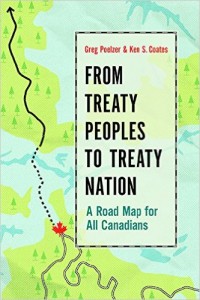One path to happiness is figuring out how the world works. Some Canadians are irritated that Catholics have their own school boards, and Jonquiere road signs are in French. There is deep-rooted justification for this, upheld by the Supreme Court many, many times. Mention the fact and you’ll draw a last cry of exasperation – “Well I still don’t like it!” – and the first glimmer of awareness that for everything there is a reason.
So authors Greg Poelzer and Ken Coates of the University of Saskatchewan observe that First Nations have rights rooted in law, and the sooner Canadians recognize the fact the better off we will be. From Treaty Peoples To Treaty Nation is a careful, concise account of the “Indian problem” written primarily for non-Aboriginal readers. Anybody is better for reading it.
Treaty Peoples is not a recitation of grievances. It seeks the light. “First Nations and Métis people in this country are facing serious, systematic and some would say intractable problems. Canadians hear about them often,” authors note. “But something vitally important is missing: there are profound reasons for optimism.”
The Territory of Nunavut was the world’s largest Aboriginal land claim. The Aboriginal Peoples Television Network is the world’s first broadcaster of its kind. Aboriginal art is prized. Forty-eight percent of Aboriginal people have post-secondary education, a higher rate than my hometown.
And yet –
When the authors wrote a 2012 Globe & Mail commentary detailing obvious problems with Canada’s treatment of First Nations and Métis, “We were taken aback by the vitriolic comments posted online,” write Poelzer and Coates. “Get a job”, wrote Globe readers; “Stop whining”; “Clean up your act – then we’ll talk”; “If I was allowed to live tax-free…yeah, I would feel disadvantaged, uh-huh.”
Treaty Peoples explains how our world works. Aboriginal rights are constitutional. The Supreme Court says so. “The learned justices are not making this stuff up!” authors explain.
Secondly, these rights have been breached by successive malicious and misguided governments. Aboriginals as late as 1959 could not vote. In 1927 they were banned from hiring their own litigators to challenge the Crown. Treaty Peoples condenses the entire history of the Department of Indian Affairs into a single, eloquent paragraph:
“The authorities’ goal was to assimilate Aboriginal people to European ways. It was believed they weren’t ready for it, so they were segregated from the rest of the Canadian population. This was not intended to be a permanent state of affairs, but rather a holding position until the educational and spiritual efforts of the state and its Christian partners could take full effect. Crucially, the Department of Indian Affairs was not an important government department. It attracted little national attention, save for occasional criticism for spending too much money.”
Treaty Peoples proposes solutions: self-government; a workable mechanism for quickly resolving land claims; student exchanges; and “a thousand acts of good will”, “spontaneous, individual, creative, heartfelt”.
At the root of 200 years of conflict is an arresting fact. Indians were not supposed to be here. “One of the strongest assumptions governing Aboriginal affairs in Canada, and the United States and Australia, was that Indigenous people would disappear,” authors write. “The logic seemed unassailable.”
Against all odds, they survived. Statistics Canada calculates within a generation they will number as many as 2.6 million people, and comprise more than a fifth of Manitoba and Saskatchewan.
They are here, they have rights, they are Canadians. Treaty Peoples is an honest attempt to explain the facts to Middle Canada, and perhaps point a way to happiness.
By Holly Doan
From Treaty Peoples To Treaty Nation, by Greg Poelzer and Ken S. Coates; University of British Columbia Press; 366 pages; ISBN 9780-7748-3087; $34.95






